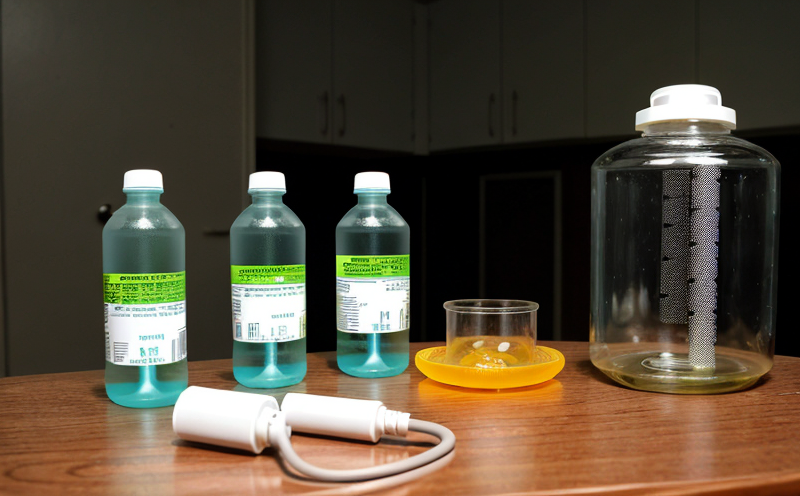ISO 13165-1 Uranium by Alpha Spectrometry Test in Water
The ISO 13165-1 standard outlines a method for determining uranium content in water using alpha spectrometry. This procedure is particularly useful for ensuring that water sources are safe from radioactive contaminants, which can be harmful to human health and the environment.
Uranium is a heavy metal found naturally in soil and rocks but can also enter water supplies through various activities such as mining, nuclear fuel production, and waste disposal. Elevated levels of uranium in water can lead to kidney damage over time if ingested or absorbed through skin contact. Therefore, monitoring uranium content in water sources is crucial for compliance with regulatory standards like the World Health Organization's (WHO) guidelines.
The alpha spectrometry technique utilized under ISO 13165-1 involves detecting alpha particles emitted by uranium isotopes. This method provides precise and accurate results capable of quantifying even trace amounts of uranium present in water samples. The testing process typically starts with sample collection, followed by filtration and digestion steps to concentrate the uranium before analysis.
Compliance with ISO 13165-1 ensures that laboratories adhere strictly to international standards when performing uranium tests in water. This standard guarantees consistent results across different facilities worldwide, enhancing reliability for regulatory bodies and end-users alike.
The precision of alpha spectrometry makes it an ideal choice for detecting low levels of uranium, making this test especially valuable in areas where groundwater contamination might occur due to proximity to industrial activities or natural occurrences.
Adhering to such standards helps protect public health by preventing the spread of hazardous materials through water supplies. By ensuring compliance with ISO 13165-1 during water testing processes, organizations contribute significantly towards maintaining clean and safe drinking water sources for communities globally.
Why It Matters
The importance of accurately measuring uranium levels in water cannot be overstated. Uranium is a highly toxic element that can pose significant risks to human health when present at elevated concentrations in drinking water or other aquatic environments. Even minute quantities of uranium isotopes like U-234, U-235, and U-238 can accumulate over time if ingested through contaminated water sources.
According to the World Health Organization (WHO), there is no safe threshold for uranium exposure via drinking water; even small amounts have been linked to kidney damage. Given these health concerns, regulatory agencies around the world enforce strict limits on permissible levels of uranium in potable waters. For instance, the U.S. Environmental Protection Agency (EPA) sets a maximum contaminant level goal (MCLG) of 3 parts per billion (ppb) for uranium in drinking water.
Implementing ISO 13165-1 ensures that laboratories provide reliable data on uranium concentrations within prescribed limits, thereby supporting effective management strategies aimed at reducing risks associated with uranium toxicity. Properly conducted tests not only help identify existing problems but also enable proactive measures to prevent further contamination incidents from occurring.
By adhering to international standards like ISO 13165-1, laboratories play a critical role in safeguarding public health by providing accurate and consistent measurements of uranium levels in water samples. This contributes directly to meeting regulatory requirements set forth by various governing bodies worldwide while fostering trust among consumers regarding the safety of their tap water.
Benefits
- Precision & Accuracy: Alpha spectrometry offers unparalleled accuracy in detecting uranium isotopes, even at extremely low concentrations.
- Regulatory Compliance: Adherence to ISO 13165-1 ensures that testing procedures meet global standards, facilitating easier compliance with local regulations.
- Enhanced Safety: Reliable detection of uranium levels helps protect public health by ensuring water supplies remain safe for consumption.
- Proactive Monitoring: Regular monitoring allows for early identification and mitigation of potential contamination issues before they become widespread problems.
The ability to detect minute quantities of uranium through alpha spectrometry is particularly advantageous in areas where natural or man-made sources may introduce this element into water supplies. By providing precise measurements, ISO 13165-1 supports informed decision-making processes that can lead to more effective environmental protection measures.
Use Cases and Application Examples
The ISO 13165-1 uranium by alpha spectrometry test finds application in various sectors including public utilities, private water treatment facilities, research institutions, and government agencies responsible for enforcing health and safety regulations.
- Public Utilities: Water utility companies use this method to ensure compliance with national and international standards regarding allowable limits of uranium in drinking water. They also employ it as part of routine monitoring programs designed to identify any emerging threats early on.
- Private Water Treatment Facilities: Private operators rely heavily on accurate uranium testing results provided by ISO 13165-1-compliant laboratories to maintain high-quality standards throughout their operations. This includes ensuring that treated water meets stringent quality criteria before being released into distribution systems.
- Research Institutions: Academic and research institutions often utilize this technique in studying the behavior of uranium under different environmental conditions, investigating its effects on aquatic ecosystems, or exploring methods for reducing its toxicity once present.
In addition to these primary applications, ISO 13165-1 finds utility in scenarios involving accidental spills from nuclear facilities, industrial accidents affecting nearby water bodies, and natural occurrences leading to increased uranium content in groundwater sources. The precision offered by alpha spectrometry enables detailed analyses that contribute significantly towards understanding complex environmental issues related to uranium contamination.





